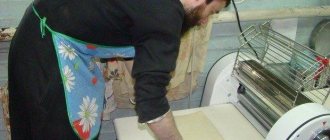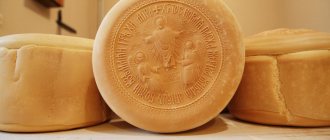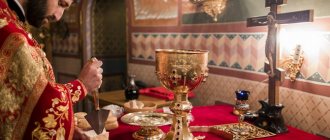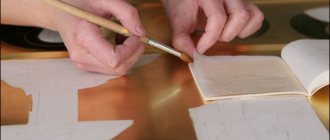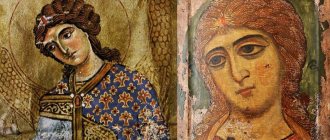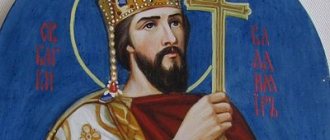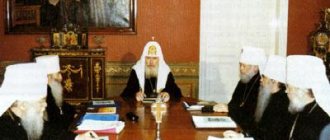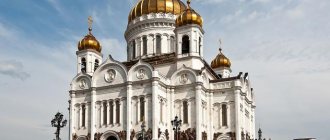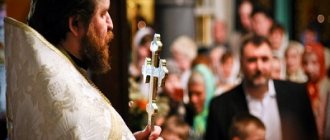The meaning of bread in church rituals
In his message, John (John 6:18) conveys the words of the Savior that He is the Bread of Life. It was not for nothing that the Lord compared himself to bread. This word has a deep meaning.
- The grain dies and is reborn in the ear. So Jesus died to return to earth in the hearts of His children, Orthodox Christians.
- Flour is a symbol of purification and processing, in order to become a prototype of the Savior, believers must pass tests and unite into one whole, one Church, the bride of Christ.
- Baking is purification by fire.
- A bread product contains many pieces, just as Jesus united his followers.
Orthodox sacred bread
Just as bread is a staple food for people, remaining the main dish on the table, so Jesus Christ is the basis and center of the Church. True believing Orthodox people begin their day with prayer and eating holy water and a piece of church bread on an empty stomach:
- prosphora;
- arthos.
Important!
Daily consumption of the Bread of Heaven opens the way to Eternal Life. More about the shrines of Orthodoxy:
- Miraculous icons of Athos
- Relics of Saint John the Baptist
- Relics of Saint Ambrose of Optina
No problem, easy work
I got, I must say, in the midst of it. It’s me, the artist, who can afford to sleep sometimes, but the guys get up early to knead the dough.
At first I only had time to turn my head - I couldn’t even keep track of what and how, but then I got used to it, and it became interesting. But as soon as I point the camera, the process is already over. The excitement really started to fill me! And the sun in the window also began to play hide and seek: it would appear, then it would hide. And the prosphora workers work and smile. Here and there I disturb them. The premises are small, but I take up a lot of space.
Just then the guys began to pray:
I remembered the lines from “Kaidash’s Family” by Nechui-Levitsky: “Meanwhile, Melashka served in Kyiv at the malt-mallow shop. She lived the first week quietly, calmly, like God was at her door. The work of the mallow maker was not difficult after the hard work of the mother-in-law. The food was good."
I looked at the prosphora workers and thought: “Never mind, not difficult work! Having time to spin like that... What kind of job did the mother-in-law have back then?!”
I stopped and began to pray in prayer to ask St. Jonah to tell me how his prosphora are made. After that, I was allowed to... I began to keep up with the workers and make shots, and ask questions about what and how. And they treated me with kindness and began to tell me...
Prosphora, its meaning and history of appearance
Prosphora is an integral part of the Liturgy; it is also called liturgical bread. The sacrament of the Eucharist, the commemoration of the deceased at Proskomedia, occurs during the reception of holy bread by Christians - a piece of prosphora.
The first mention of church bread prepared for sacrifice is in the Old Testament (Leviticus 7:13), when God ordered leavened baked goods to be prepared for sacrifice. In the tabernacle, during the campaign of Moses and the Jewish people through the desert, also by command of the Creator, there was always the bread of show, but unleavened. It had two parts - symbols of earthly human life and heavenly Divine life. The showbread is a type of Jesus, who became the Bread of Life, being God and man.
Prosphora breads are baked by specially trained people, prosphora bakers, and at large churches there are prosphora bakeries where holy bread is baked. The recipe for church baked goods is based on holy water, wheat flour, leaven and salt. Hops, raisins or ordinary yeast are used as starter culture.
Holy water is a symbol of grace, leaven is the life-giving power of the Holy Spirit.
Important! A distinctive feature of the prosphora from other bread products in the church is the symbolic abbreviation placed in the middle of the upper part.
Prosphora
To apply an image signifying that Christ is victorious, special forms are used. The holy loaf consists of two parts, as in Old Testament times, symbolizing Jesus both man and God.
Five prosphoras are prepared for Proskomedia, each of which has its own purpose. From one, as a prototype of the Lamb, pieces are taken out for the communion of believers; the other pays tribute to the memory of the Mother of God, saints and deceased people.
After the end of the Liturgy, believers eat prosphora with reverent prayer and reverence, communing with the body of Christ, accepting His sacrifice for the life of all believers. The remaining pieces of prosphora - antidor - are distributed to parishioners to take after morning prayers.
Relaxing under four blankets
After taking the prosphora out of the oven, they are laid out on trays and covered with several layers: dry linen, then wet, and then dry again and a blanket on top. In this state, the prosphora “rest” for about an hour. When they become soft and cool, they are placed in baskets or boxes, where nothing but prosphora is placed at all.
Service prosphora is prepared in the same way, but has its own characteristics. The baking process should be under constant supervision, and it is best to pause it in order to make additional punctures and pressings, to release air. If it burns, you will have to change the temperature.
And even if you follow everything to the smallest detail, every time everything will be a little different. Because in nature there is no identical interaction of natural components, and external forces also influence the result. Create, and may God help you!
Antidor: how and where to take it
Translated from Greek, antidor means instead of gift, as mentioned above, these are pieces of prosphora from which the Lamb was taken out. Sacred pieces of antidor are taken from the prosphora with a spear and mean gifts or sacred secrets. The lamb part is cut out of a large prosphora, and the antidor is formed from the scraps.
There is a whole ritual for accepting antidor from the hands of a clergyman. Before accepting the holy bread, your hands should be folded crosswise, with the right hand lying on top, bending slightly, you should kiss the priest’s hand giving the antidor. The antidoron is eaten in the temple, in the greatest reverence, as part of the sacrifice of Jesus Christ, which received the consecration of Heaven after being offered on the altar.
Antidor - particles taken out at proskomedia
The church custom of distributing pieces of prosphora after the Liturgy and Communion dates back to the seventh century. This rule was established at the Ninth Council of Kamnet, which took place in Gaul. In the first years after the death of Jesus, people took communion every day, then this action began to occur much less frequently.
As a rule, at present, most Orthodox Christians come to the Sacrament of Communion during great Lents. In order not to deprive the rest of the parishioners of the grace to share bread with the Lamb, the priesthood installed an antidor, a dish with the edges of the main prosphora cut into small pieces. Hence the name, antidor - a gift for those who have not participated in the Eucharist for a long time.
When is the artidor distributed in the temple?
According to the Charter of the Church, the priest must distribute the antidor during prayer during the performance of Psalm 33, after taking the sacrament.
Psalm 33
1 Psalm of David, when he feigned madness before Abimelech and was driven away from him and withdrew.
2 I will bless the Lord at all times; His praise is continually in my mouth.
3 My soul will glory in the Lord; The meek will hear and rejoice.
4 Magnify the Lord with me, and let us exalt His name together.
5 I sought the Lord, and He heard me, and delivered me from all my dangers.
6 Those who looked to Him were enlightened, and their faces were not ashamed.
7 This beggar cried, and the Lord heard and saved him from all his troubles.
8 The angel of the Lord encamps around those who fear Him and delivers them.
9 Taste and see how good the Lord is! Blessed is the man who trusts in Him!
10 Fear the Lord, all you His saints, for there is no want among those who fear Him.
11 The people of Skim are poor and hungry, but those who seek the Lord lack no good thing.
12 Come, children, listen to me: I will teach you the fear of the Lord.
13 Does a person want to live and does he love long life in order to see good?
14 Keep your tongue from evil and your lips from deceitful words.
15 Avoid evil and do good; seek peace and follow it.
16 The eyes of the Lord are on the righteous, and His ears are on their cry.
17 But the face of the Lord is against those who do evil, to destroy the memory of them from the earth.
18 [The righteous] cry, and the Lord hears, and delivers them from all their troubles.
19 The Lord is close to the brokenhearted and will save those who are humble in spirit.
20 Many are the sorrows of the righteous, and the Lord will deliver him from all of them.
21 He keeps all his bones; not one of them will be crushed.
22 Evil will kill the sinner, and those who hate the righteous will perish.
23 The Lord will redeem the soul of His servants, and none of those who trust in Him will perish.
About other psalms:
- Psalm 89
- Psalm of David 63
- Psalm of David 19
It is important to know that antidor is taken on an empty stomach, such a small morning fast.
The Antidoron in no way replaces the Holy Blood and Body of Jesus Christ. When accepting it, one prayer is read - a request for the blessing of drinking holy water and a piece of prosphora.
Prayer for accepting Holy water and prosphora
Lord, my God, may Your holy gift be: prosphora and Your holy water for the remission of my sins, for the enlightenment of my mind, for the strengthening of my mental and physical strength, for the health of my soul and body, for the subjugation of my passions and infirmities by infinite mercy To Your prayers, Your Most Pure Mother and all Your saints. Amen.
Holy bread. About obedience to the prosphora boy
Bread in the Church is a symbol of Christ. He Himself said about this: “I am the Bread of Life” (John 6:48). If earthly bread nourishes human life, then Christ, the heavenly Bread, introduces human life to the fullness of Divine life in eternity.
Service of the Mother of God prosphora |
An integral part of the liturgical life of the Church is the prosphora, and therefore the obedience of the prosphora bearer is of particular importance.
Behind the apparent simplicity of this godly activity, there are many subtleties, secrets and hidden activities. One of the oldest inhabitants of the Moscow Sretensky Monastery, Hegumen Cyprian (Parts), tells us about this. We will learn about why the Lord created wheat, why prosphora can be baked everywhere on Earth, and why the obedience of the prosphora baker, which Father Cyprian has been carrying out for more than ten years, is considered so important in monasteries.
***
– Father, why is obedience to the prosphora drinker considered one of the most important in monasteries?
– Liturgical life, as we know, cannot exist without prosphora. And without the Liturgy the Church cannot live. This means that the place second after the temple is the prosphora, where bread is baked especially for the Liturgy.
Proskomedia. Sretensky Monastery. Photo: Anatoly Goryainov |
– Who should and can bake prosphora? How was this accepted in Rus'?
– In monasteries, of course, monks or nuns were assigned to this obedience. And for parish churches, prosphora, as a rule, was baked either by pious widows or by girls who lived in celibacy - that’s what they were called: prosphora.
Hegumen Cyprian at obedience. Photo: Hierome Ignatius (Shestakov) |
This happened out of a reverent attitude towards the prosphora.
Also, out of reverence, they began to add holy water to the prosphora mix - in fact, this is not a necessary requirement, but for the sake of reverence they do so. If a “white” priest serves in a rural parish and his mother knows how to bake prosphora, then, of course, she will do it - and who else? And that's okay. We must proceed from real conditions.
In monasteries now, of course, they mostly bake prosphora themselves - both for themselves and for sale. Parish churches either bake themselves or, more often, buy them.
In ancient times, everyone could bake prosphora - it was an offering to the temple: the best were selected from them, at which the Liturgy was served. Almost all housewives knew how to bake bread, because it was a common thing, and any of them, being a church person and knowing the requirements (it must be leavened bread, salt, water, flour), could bake prosphora at home and bring it to church .
In Greece, today you can buy prosphora in a store and bring it to the temple as your offering.
The brethren of the Sretensky Monastery in the Holy Dormition Pochaev Lavra, July 2013. Photo: Hierom. Ignatius (Shestakov) |
– What needs to be done to ensure that the reverent, prayerful attitude towards baking prosphora does not stop? So that it doesn't become a craft?
– It doesn’t stop. I didn’t notice that it stopped: neither in parishes, nor in monasteries, where I had to attend prosphora, nor in private prosphora, I didn’t see it somehow deteriorating. I don't think there is any danger here. I haven't observed this.
– I had to read that baking prosphora is called a church art. How did you learn to bake prosphora?
“Previously, we didn’t have a special prosphora in the monastery, and it was my responsibility to provide the church with prosphora when I was a sacristan. One “fine day”, due to my oversight, it turned out that there were no small prosphoras for the people for tomorrow. There were official [1] ones, but they didn’t stock up or buy them for the people in advance. This was discovered on Friday, the prosphora was needed on Saturday morning, and we only went for them on Saturday afternoon.
At the obedience in the prosphora of the Sretensky Monastery It was impossible to leave the people without prosphora. What to do? We had one employee in the refectory, Lyubov, who had already baked prosphora before and was knowledgeable about this matter. She was finishing her shift when I came into her kitchen and said: “Aunt Lyuba, haven’t you baked prosphora before?” - "Yes. What do you need? - “Yes, we don’t.”
We found American flour - terrible, bleached flour - French yeast, and this is what we used to bake the first prosphoras, in the kitchen oven where cookies had been baked before. The prosphoras, as I now understand, turned out terrible, they smelled like cookies, but they were there, and the people were satisfied.
But this thing captivated us, and we decided to try baking ourselves. At that time, my father, Hierodeacon Cleopas, was under my command, and so we started baking at night in the kitchen. Of course, we were only able to hold out for a month - then we just collapsed: we didn’t sleep at night, not every night, but still - but we got our own prosphora. And then we began to ask the governor’s father to have our own prosphora. He gave his blessing, and after renovations in a new building, we furnished it. This was in 2000.
– You just said: terrible American flour, French yeast... But many may think that this, on the contrary, is wonderful. What kind of flour and yeast should it be?
– Why did I scold American flour? Americans do not bleach all their flour with chlorine, but very often. This is done simply for the sake of color. They essentially ruin it.
French instant yeast is not very suitable for baking prosphora. They immediately give off a lot of carbon dioxide, that is, they come up quickly, which is not suitable for simultaneous baking of a large batch of prosphoras - you can’t keep track of them, they just “run”. Therefore, it is better, of course, to use our domestic yeast.
"Lux" is quite suitable. The good ones are from Voronezh. And dried Voronezh yeast also gives good results. Dried yeast is easier to store, but compressed yeast is stored for no more than a month, and even then its lifting power decreases... You can use sourdough.
At some time, a buzz began that “only with sourdough, before they baked with sourdough, but now with yeast...” But this was simply out of ignorance, people said: in fact, the same yeast works in sourdough, only wild. Lactic acid bacteria and yeast, of different types, are found almost everywhere. If you simply add water to the flour and put it in a warm place to create the necessary conditions, this yeast begins to multiply: that’s what you have, actually, sourdough.
Freshly baked prosphora. Sretensky Monastery. Photo: Hierome Ignatius (Shestakov) |
At one time, they learned to grow yeast in large quantities in factories.
Then, through selection, yeast was developed that produces more carbon dioxide and is resistant to temperatures. What is yeast? These are single-celled fungi that can be subjected to selection, producing more stable forms that can easily ferment the sugars present in flour - that’s all.
Not only that: in the past, sourdough was called yeast. There was no division. If we take Elena Molokhovets’ book “A Gift for Young Housewives”[2] and look at the “Bread” section, we will see that she doesn’t even have the word “sourdough”, she writes: “yeast”.
But in our understanding, this is leaven. Sourdoughs were abandoned in bread baking because they are more capricious. If you want to bake prosphora with sourdough, this is quite possible. You just need to add the starter starter more often so that the prosphora does not sour and there is no high acidity.
On Mount Athos they bake prosphora with sourdough, in Vatopedi, at least, and in a number of other monasteries - they still bake it the way they used to bake it. They renew the leaven, that is, they put in fresh leaven, twice a year - on the Exaltation of the Cross, for example, and on the Week of the Worship of the Cross. Or on Holy Saturday - I don’t remember exactly, but this can be clarified if anyone wants. This leaven is called miraculous, but the point is not that it rises without yeast. There is yeast there.
The fact is that it matures very quickly - literally while the service is going on. This is where the grace of God lies - in the fact that this happens very quickly.
But it will also happen anywhere else. There is no place on Earth where people live - well, except perhaps some northern islands, where nothing spoils at all - where there would be no yeast and lactic acid bacteria: the Lord arranged it so that prosphora can be baked everywhere.
Moreover, this is also surprising: we perform proskomedia on wheat bread, but only wheat has unique baking qualities. No other cereal has such qualities. The Lord created wheat so that the very leavened bread on which the Liturgy could be celebrated could be baked from it.
- Father, why do the Greeks serve on one prosphora, and we have five?
– Actually, this is a tradition. Moreover, it is a tradition that is not a dogma. Whether to serve the Liturgy on one prosphora, or on two (as often they served on Athos), or on five, or on seven – there is no fundamental difference. You can serve at one prosphora. Well, there are no prosphoras - there is only one: where to go? You can serve the Liturgy. Why not? Then it is necessary to take out from it, as the Greeks take out: the central one is the Lamb, and from the remaining parts the remaining particles: Mother of God, nine orders of saints, about health, about repose... The Greeks have on their seal, if anyone has seen, all of our five seals are depicted: in the center - the Lamb, on the right, on the left - the Mother of God, nine ranks of saints.
This is a matter of local tradition.
In the main things we must have unity, but in other respects diversity is allowed. This is precisely acceptable diversity. Old Believers came to Athos in the second half of the 19th century to find out who was mistaken: they or the “Nikonians”. Athos was indeed the custodian of church traditions and rituals. They turned to the confessor of the Panteleimon Monastery, Hieroschemamonk Jerome - I don’t remember exactly his last name, he was a famous ascetic. He answered them: “As we served in ancient times on Mount Athos, so we serve now.” And they served at two prosphoras: one for Agnitschnaya, the second for the rest. Moreover, he gave a very simple explanation for this: due to poverty. It is necessary to serve in a cell somewhere, and in order to spend less, due to poverty the hermits were allowed to serve in two prosphoras, and there is no harm in that. This is an ordinary, normal thing. We once served at seven prosphoras. And there was no trouble either. How many prosphoras are prepared if a bishop serves? Seven. The usual five plus two prosphoras for the bishop. The same seven prosphoras are obtained. This is a matter of practice, and there is no need to bring this to some kind of rigid norm.
– If we go back to that night when you and Aunt Lyuba baked prosphora for the first time... Did you gain all subsequent knowledge by experience or did you study somewhere? And is this taught anywhere at all?
– You know, we learned simply: firstly, of course, Aunt Lyuba taught; secondly, we learned from experience and from our mistakes.
We baked small prosphoras, but it took us a long time to make service ones. We bought them at the Danilov Monastery. And then one Sunday, as usual, Father Viceroy came to the service and asked: “Father Cyprian, whose service prosphora do we have?” - “Father, the Danilovskys.” - “Why Danilovsky? We have our own prosphora.” - “Father, we don’t know how yet, we need to learn...” He says: “Okay, that’s it. We don’t buy prosphora, you bake it yourself.”
I immediately began to count in my mind how many Danilov prosphoras I had left, and I realized that there was still enough for weekdays, but for the next Sunday there were no Lamb prosphoras. Where to go? Where can I study? He began to ask a nun he knew, a prosphora server. I called her at the Conception Monastery - Mother Sergia was so wonderful, already deceased. I said to her: “Mother, can I learn how to bake prosphora from you?” She says: “Maybe it’s better to go to Father Adrian in Novospassky?” I say: “Mother, can I come to you?” - “Well, you can come.” - “When do you have baking?” - "On Thursday".
I worked with them all day. Of course, I had some experience, but then I saw my gross mistakes, they taught me how to roll the bottoms to make balls like this... The bottoms are the lower part of the prosphora.
And here’s another catch: I worked all day baking for them, and they bake for sale, but I can’t say to Mother Sergius: “Sell,” because my father-vicar forbade me to buy, and “So give me” is my tongue. doesn't turn. She might have given it, but I didn’t ask...
And I only had Friday evening left for baking. Well, thank God, I saw my gross mistakes, corrected my batch, and what do you think? On the very first evening, the prosphora turned out absolutely normal. God's mercy!
Hegumen Cyprian at obedience. Photo: Hierom. Ignatius (Shestakov) |
Of course, he prayed and asked - he asked the Great Martyr Barbara, because it was her memory in the evening... The result was prosphora!
Sunday, Liturgy, the vicar sees the prosphora, normal service ones... “Father Cyprian, whose prosphora?” - “Father, ours.” - "What happened to you?" - “Father, the mercy of God.” You see how: if the father governor had not said: “That’s it, we bake ourselves,” how much longer would I have been “sitting” on the little ones?
It’s best to learn from other prosphora makers, to work directly on the prosphora so that they can show you on the spot how to bake, because you can’t write everything in a manual. I can’t imagine how you can show how to roll the same bottoms correctly if you don’t see it, if you don’t feel the dough with your hands.
To learn how to bake prosphora, you need to bake together with a good prosphora pan and even visit different prosphora pans - sharing experience is very important.
Freshly baked prosphora. Sretensky Monastery. Photo: Hierome Ignatius (Shestakov) |
– What is the prosphora of the Sretensky Monastery today?
– A workshop for an ordinary small bakery production. Nothing special. An oven, a dough mixer, a rolling machine through which the dough is processed (so-called rubbing) so that it acquires a homogeneous, dense structure. Cutting tables, proofing cabinets, where prosphora is suitable before baking.
- Who bakes? Monks, novices or do you hire someone?
– We don’t have hired people, I bake the service prosphora myself, because the batch is small, I have time, no help is required, the equipment allows it. But the small prosphoras... At our prosphora, seminary students are obedient - they help with cutting, because we need to cut about 3 thousand prosphoras in two and a half hours.
Service prosphora |
– How often does baking take place?
- According to need. It depends on the holidays: the more holidays there are, the more often you need to bake. Well, we bake service prosphora three times every two weeks.
– Do students like this obedience?
– How many seminarians have we had as assistants, you know, such a question does not arise: “Do you love this obedience?” They work hard, they try. I am grateful to the guys for their help and diligence, because they have to carry out this obedience in the evenings, after dinner, when they have free time, that is, this is an additional burden for them. But they hold on to it and work hard. They sometimes carry out this obedience for years until they graduate from seminary. So they want it. You see, baking prosphora... a person should like this business. People have different styles: some paint icons, others do carpentry. Well, he likes the business, he knows it. And this matter—baking prosphoras—should be treated the same way. Otherwise it won't work. Because you understand how? We still have something to do with living things: living yeast... So that’s the thing. A person must like the field in order to successfully complete it.
– So it won’t work mechanically?
– Mechanically – no, it’s impossible. I didn't realize this before I got into baking. He had a completely different attitude towards prosphora. Firstly, I didn’t know what kind of work it was. Secondly, I didn’t understand the approach at all: just think, what’s wrong with baking prosphora? With this in mind, I came to one wonderful prosphora teacher, Father Adrian at the Novospassky Monastery. “Tell me,” I say, “the recipe.” And he: “Do you know what gluten is? Do you know what IDK is?” These are the characteristics of flour. I thought: “Why is he telling me all this? I just need the recipe!”
On Mount Tabor. Pilgrimage to the Holy Land, 2005. Photo: Hierome Ignatius (Shestakov) |
And then, when I started baking myself, I realized that I needed to know this, that it was not in vain that he told me these things, because without taking them into account, it is impossible to bake prosphora successfully.
Either there must be an enormous amount of experience transferred, or one simply must understand what kind of processes are taking place there. By the way, books on baking, ordinary books that can be purchased helped me a lot in baking prosphora, in understanding the baking process - essentially bread, only special bread. They give an understanding of what is happening there, and this is not superfluous. Moreover, these books helped us in another way: after all, we bake bread in prosphora for the brethren. In general, when baking prosphora, the first thing is continuity. And the second is your experience, which is irreplaceable. And as a guide, books on baking: they help.
Bread with the smell of the sun: prosphora
Once upon a time in my distant childhood, returning from the bread store, I could eat half a loaf of bread and then guiltily apologize to my mother that it was too appetizing. Nowadays you rarely find this unique smell. We are sliding more and more into artificiality, substitutes for taste and smell, and moving away from nature. What a person inhales, what he consumes, is how he lives, and the quality of his existence largely depends on how he does it.
Often visiting the Ioninsky Monastery, more than once or twice I saw how whole flocks of children circled around the monastery prosphora and, having received the coveted still hot prosphora, ran off to play further with happy faces. The Kiev Botanical Garden, where the monastery is located, is always crowded: there are a lot of children and youth. God works in mysterious ways. Who knows, maybe by sharing the prosphora with someone, the child will open the doors to the church and his parents...
Do you know how prosphora is made? The recipe is practically the same, but the tastes are different. Why do people go to another church to buy prosphora when they can bake them themselves? And many from afar come to the monastery to St. Jonah of Kyiv for prosphora. We know the matter, there is a reason, probably...
So I decided to come in and see how my favorite sunny bread is made.
Prosphornia
The connection between prosphora and prayer
Saint John of Kronstadt said that the most important commemoration for the deceased is proskomedia. From the biography of St. Alexey Shepelev (Goloseevsky) we learn about the importance of commemorating the dead with the help of prosphora at the proskomedia
In 1896, the glorification of St. Theodosius of Chernigov took place; Father Alexy was tasked with redressing the relics of the saint. After completing the assignment, Father Alexy prayed. And he saw a vision where Saint Theodosius asked that his deceased parents, priest Nikita and Mary, be remembered at the proskomedia. Father Alexy considered his prayers weak in comparison with the prayers of the holy saint Theodosius. But the saint said that prayers performed with the removal of particles from the prosphora are higher than his prayers
From the biography of St. Alexey Shepelev (Goloseevsky) we learn about the importance of commemorating the dead with the help of prosphora at the proskomedia. In 1896, the glorification of St. Theodosius of Chernigov took place; Father Alexy was entrusted with re-dressing the relics of the saint
After completing the assignment, Father Alexy prayed. And he saw a vision where Saint Theodosius asked that his deceased parents, priest Nikita and Mary, be remembered at the proskomedia. Father Alexy considered his prayers weak in comparison with the prayers of the holy saint Theodosius. But the saint said that prayers performed with the removal of particles from the prosphora are higher than his prayers.
From the life of St. Gregory Dvoeslov we know about the rescued captive. When a prayer was made for his health and particles were taken out of the prosphora, at the same time the chains fell from the prisoner and he became free.
So, did the classic ever wear a prosphora?
I walked home and thought: what kind of “easy and dust-free” work did the classic writer write about? Has he actually ever been to a prosphora service, let alone a Lavra one?
All our troubles come from ignorance, from arrogance and disbelief. If everyone, at all posts and in all areas, worked as the prosphora workers work and believe, the people would live in prosperity, and the earth around would be fragrant. There would be no war, no destruction. The fields would not be strewn with mines and shrapnel, but with elite varieties of selected wheat and rye. And our neighbors would respect us and come for our products.
God grant that we live to see this soon, and that our children enjoy the smell of freshly baked bread.
Forgive us, Lord, our sins and give us ordinary earthly happiness!
Photo by the author
sacrificial lamb
It should be noted that during worship, not the whole bread is used, but its particles. “With a spear” (in memory of how Christ’s heart was pierced with this weapon on the cross), the prosphora is divided into pieces that signify the Lamb of God, the sacrifice made by Jesus for the sake of people. Usually 5 loaves of bread are baked for Proskomedia. One is used as the Lamb and is given communion to the faithful during the liturgy. The rest are divided by the priest in memory of the Mother of God. They eat particles of these prosphoras, remembering her, the holy martyrs, and the compilers of the liturgy. But this number is aimed specifically at the official part of the service. For the needs of the church and parish, as many prosphoras are baked as parishioners submit notes “To health” and “To repose.”
